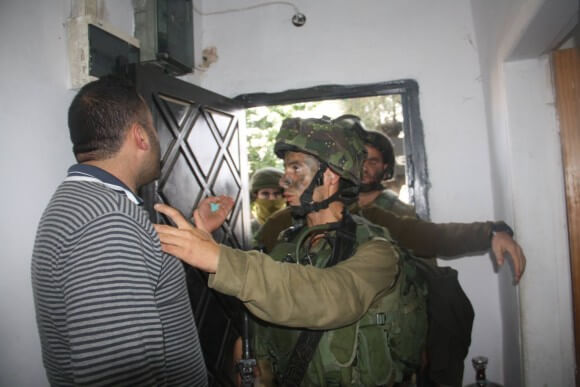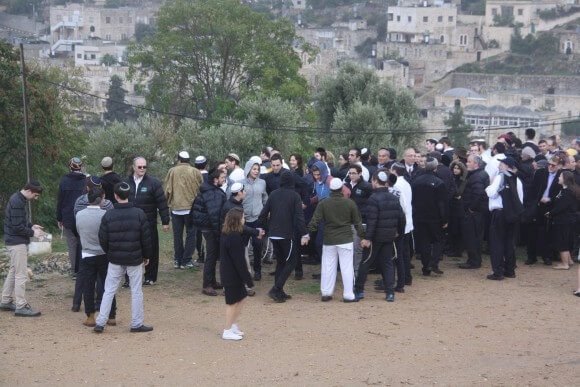Early Saturday morning Issa Amro, 35, awoke to dozens of Israeli soldiers entering his house, which contains offices of the activist group Youth Against Settlements. The soldiers presented him with a military order to seize control of the Hebron house for 24 hours. Amro, along with an Italian journalist on assignment with an Israeli paper and two international activists who were staying at the Youth Against Settlements advocacy center, were then ushered into a single bedroom where, with the exception of escorted bathroom breaks, they were forced to stay until after daybreak Sunday.
At the same time, between 20 and 25 soldiers also entered the neighboring house belonging to the Abu Talal family. Two parents and three children were similarly moved into one room until the following day.
“I managed to hide one of my phones, I was writing to journalists and talking to them to try to get them to request the Israeli government leave the house,” Amro said. Amro’s other cellphone and computer were confiscated, along with those belonging to the three foreign nationals held inside of the stone building in the Tel Rumeida neighborhood of Hebron.
The four stayed awake overnight, sending updates on the concealed phone as a method of keeping busy. “I was afraid during the night,” Amro said, “You know, you’re stuck in a room and there are many soldiers around you with guns and you don’t know what they are thinking.” Meanwhile soldiers rummaged through the house, and an office/studio on the second floor breaking camera equipment. When the Israeli forces departed Sunday morning, one officer told Amro he could file for a reimbursement.
“I told him I won’t ask for compensation from occupation,” said Amro.

Israeli soldiers entering the Youth Against Settlements’ house in Hebron early Saturday morning. (Photo: Youth Against Settlements)

Israeli settlers and soldiers gathered outside of the Youth Against Settlements house in Hebron, Saturday afternoon. (Photo: Youth Against Settlements)
The bedroom where the four were held does have windows, but metal shades were drawn keeping the group blind to events taking place outside the front door. A few hours into their confinement, shortly before noon, nearly 1,000 Israelis gathered and started chanting in Hebrew “the Jewish nation lives,” “death to Arabs” and insults to Islam’s prophet.
“They were rejoicing, they were happy and singing, and greeting the soldiers as they took over our house,” said Amro.
“I heard voices, and I heard the sound grenades,” Amro noted of commotion that broke out when a group of Palestinians living nearby also came to the area, calling out in Arabic, “Hey settlers, get out.” The masses stayed until sunset, when the settlers headed downhill toward Hebron’s Old City.
Standing among the crowd, Amro’s colleague Sohabi Zahda, 32, saw the settlers re-group at nightfall outside of the Ibrahimi Mosque or Cave of the Patriarchs, a split Jewish and Islamic holy site that serves as a mosque and as the resting place for the tombs of the patriarchs and matriarchs of the old testament and the Qur’an.
Much like recent religious tensions over the compound of the al-Asqa mosque in Jerusalem, dueling faith claims over Hebron’s sacred sites has caused the Ibrahimi Mosque to be the site of violence. In 1994 Jewish extremist Baruch Goldstein opened fire on Muslim worshippers during morning prayer, killing 29 and injuring another 125 before he was killed.
In the aftermath of the Ibrahimi Mosque massacre, the Israeli army ordered the closure of Shuhada Street, a central roadway in Hebron that has since been transformed into a settler stronghold– and a ghost town for Palestinians.
In communication via the clandestine mobile phone, Amro told Zahda late Saturday that the four trapped in the bedroom of the Youth Against Settlements’ house had not eaten or drank since the army entered. Amro then coordinated with the IDF in the next room over—“sometimes the soldiers were peeking into the room, sometimes the door was open”—to get an OK for Zahda to deliver sandwiches, wraps and cookies.
“They didn’t allow me to enter the house; when I arrived at the door the soldiers took the food,” Zahda said. Everyone ate, except for Amro.
“I announced that I would be on a hunger strike, I thought that the army wouldn’t be in the house for one day, I thought that maybe they would stay for weeks,” said Amro of his one-man protest.
Hebron is the West Bank’s largest city with more than 200,000 Palestinian residents. Israelis first established a settlement in Hebron on Passover of 1968 under the stewardship of the extremist organization Gush Emunim. They viewed their community as a revitalization of a Jewish presence in the city that had been suspended after a 1929 massacre in which 66 Jews were killed during the height of the Arab riots that year.
The presence of settlers in the heart of Hebron has since grown from a handful at the start of Israel’s 1967 occupation of the West Bank to nearly one thousand who reside inside of H2, the inner fifth of the city, which is under full Israeli security control per the Hebron Protocol of the Oslo Accords.
In late October the Israeli military ordered a closed military zone over all of H2, preventing the entry and exit of Palestinians not registered as residents. In the days preceding the declaration Palestinians were required to obtain a resident number as proof for passage.
Yet some did not comply with the edict.
“No, I refused to register. I told them I am not a number, I am a human being,” said Amro, who now travels in and out of the quarter through fields that buffer the outskirts of Hebron in order to bypass Israeli checkpoints.
Israeli soldiers commandeering Palestinian houses in the West Bank was common practice during both Intifadas, or uprisings, over the past three decades. More recently soldiers took control of Palestinian homes and a school outside of Hebron last spring during Operation Brother’s Keeper, an army search to retrieve three Israelis youths who were abducted and killed by self-identified Hamas cell in the West Bank.
A spokesperson for the Israeli army said that from October 1st to November 1st Palestinians from Hebron carried out or attempted 24 attacks against Israeli civilians and police, 14 of which were inside of the city of Hebron, killing one Israeli.
Source Article from http://mondoweiss.net/2015/11/israeli-hebron-activist
 RSS Feed
RSS Feed















 November 9th, 2015
November 9th, 2015  Awake Goy
Awake Goy  Posted in
Posted in  Tags:
Tags: 













